engine HONDA ACCORD 2002 CL7 / 7.G User Guide
[x] Cancel search | Manufacturer: HONDA, Model Year: 2002, Model line: ACCORD, Model: HONDA ACCORD 2002 CL7 / 7.GPages: 223, PDF Size: 3.8 MB
Page 68 of 223
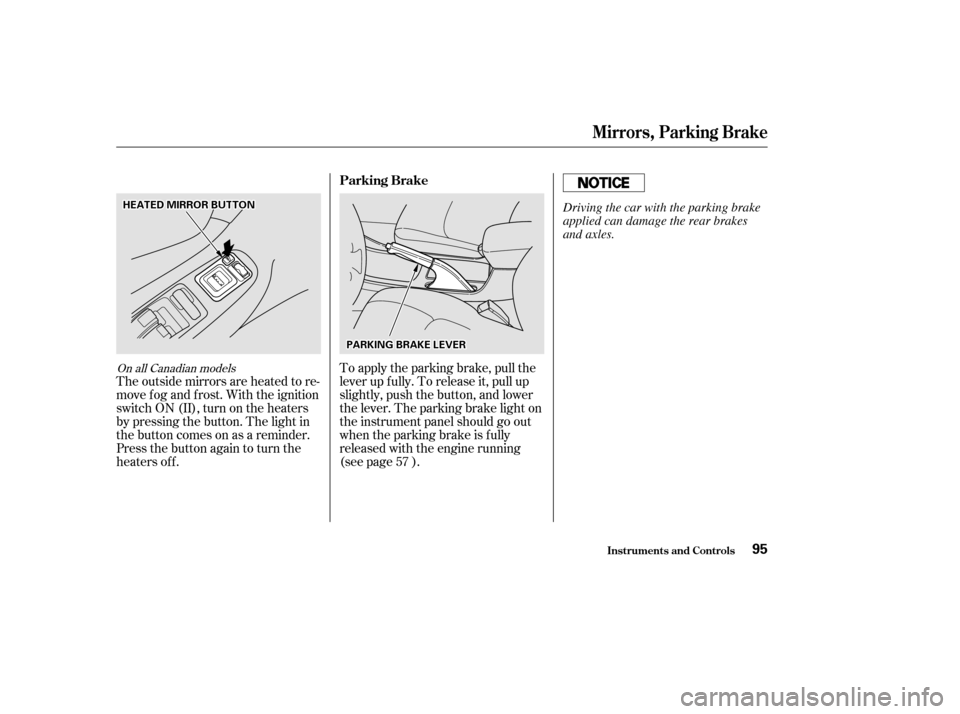
To apply the parking brake, pull the
lever up f ully. To release it, pull up
slightly, push the button, and lower
the lever. The parking brake light on
the instrument panel should go out
when the parking brake is f ully
released with the engine running
(see page ).
The outside mirrors are heated to re-
move fog and frost. With the ignition
switchON(II),turnontheheaters
by pressing the button. The light in
the button comes on as a reminder.
Press the button again to turn the
heaters of f .
57On all Canadian models
Inst rument s and Cont rols
Mirrors, Parking Brake
Parking Brake
95
PPAARRKKIINNGGBBRRAAKKEELLEEVVEERR
HHEEAATTEEDDMMIIRRRROORRBBUUTTTTOONNDriving the car with the parking brake
applied can damage the rear brakes
and axles.
Page 77 of 223
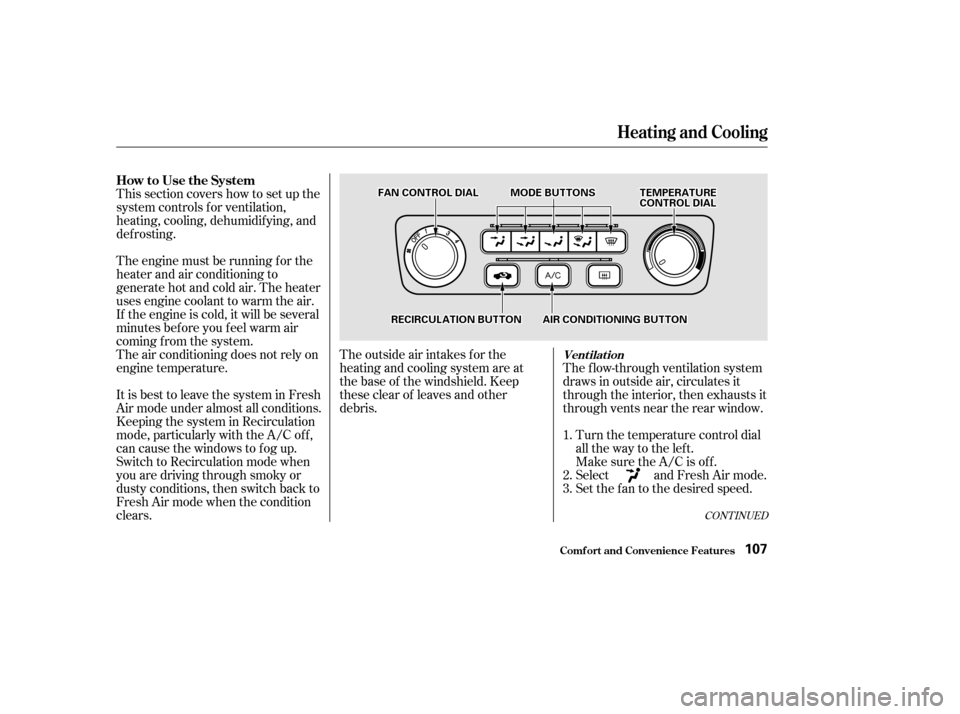
CONT INUED
The f low-through ventilation system
draws in outside air, circulates it
through the interior, then exhausts it
through vents near the rear window.Turn the temperature control dial
all the way to the lef t.
Make sure the A/C is of f .
Select and Fresh Air mode.
Set the f an to the desired speed.
The outside air intakes f or the
heating and cooling system are at
the base of the windshield. Keep
these clear of leaves and other
debris.
This section covers how to set up the
system controls f or ventilation,
heating, cooling, dehumidif ying, and
def rosting.
The engine must be running f or the
heater and air conditioning to
generate hot and cold air. The heater
uses engine coolant to warm the air.
If the engine is cold, it will be several
minutes bef ore you f eel warm air
coming from the system.
It is best to leave the system in Fresh
Air mode under almost all conditions.
Keeping the system in Recirculation
mode, particularly with the A/C of f ,
can cause the windows to fog up.
Switch to Recirculation mode when
you are driving through smoky or
dusty conditions, then switch back to
Fresh Air mode when the condition
clears.
The air conditioning does not rely on
engine temperature.
1. 2. 3.
Heating and Cooling
Comf ort and Convenience Feat ures
Vent ilat ion
How to Use the System
107
TTEEMMPPEERRAATTUURREECCOONNTTRROOLLDDIIAALLFFAANNCCOONNTTRROOLLDDIIAALL
AAIIRRCCOONNDDIITTIIOONNIINNGGBBUUTTTTOONN
MMOODDEEBBUUTTTTOONNSS
RREECCIIRRCCUULLAATTIIOONNBBUUTTTTOONN
Page 78 of 223

For saf ety, make sure you have a
clear view through all the windows
bef ore driving away.To shut of f the system temporarily,
turn the fan speed and temperature
control dials all the way to the lef t.
You should shut the system
completely of f only f or the f irst f ew
minutes of driving in cold weather,
until the engine coolant warms up
enough to operate the heater. Keep
the fan on at all other times so stale
air does not build up in the interior.
Start the engine.
Select .
When you select , the
system automatically switches to
Fresh Air mode and turns on the
A/C.
Switch the fan and temperature
controls to maximum.
To rapidly remove exterior f rost or
ice f rom the windshield (on very cold
days), f irst select the Recirculation
mode. Once the windshield is clear,
select the Fresh Air mode to avoid
f ogging the windows. These settings direct all the air f low
to the defroster vents at the base of
the windshield and the side window
def roster vents. The air f low will get
warmer and clear the windows faster
as the engine warms up. You can
close the side vents with the dial
underneath each vent. This will send
more warm air to the windshield
defroster vents.
To remove exterior f rost or ice f rom
the windshield and side windows
after the car has been sitting out in
cold weather: 1. 2. 3.
Heating and Cooling
Comf ort and Convenience Feat ures
To Turn Everything Of f
110
Page 79 of 223

The automatic climate control
system in your Honda picks the
proper combination of air condi-
tioning, heating, and ventilation to
maintain the interior temperature
you select. The system also adjusts
the fan speed and air flow levels.
The direction of air f low f rom the
vents in the center and each side of
the dashboard is adjustable.To adjust the air f low f rom the
center vent, move the tab up-and-
down and side-to-side.
The climate control system draws air
through the exterior vents at the
bottom of the windshield. Keep
these vents clear of leaves and other
debris.
For the climate control system to
provide heating and cooling, the
engine must be running. On the driver’s-side vent, move the
vent up-and-down and move the tab
side-to-side. On the passenger’s-side
vent, move the tab up-and-down and
move the vent side-to-side.
Thesideventscanbeopenedand
closed with the dials underneath
them.
CONT INUED
Only on EX V-6 model
Climat e Cont rol Syst em
Comf ort and Convenience Feat ures111
CCEENNTTEERRVVEENNTTSSDDRRIIVVEERR’’SS--SSIIDDEEVVEENNTT
Page 125 of 223

Bef ore you begin driving your Honda,
youshouldknowwhatgasolineto
use, and how to check the levels of
important f luids. You also need to
know how to properly store luggage
or packages. The inf ormation in this
section will help you. If you plan to
add any accessories to your car,
please read the inf ormation in this
section f irst..............................
Break-in Period . 194
.........................................
Gasoline . 194
.........
Service Station Procedures . 194
................
Filling the Fuel Tank . 194
....................
Opening the Hood . 196
...............................
Oil Check . 198
.........
Engine Coolant Check . 200
...............................
Fuel Economy . 201
.....................
Vehicle Condition . 201
...........................
Driving Habits . 201
...
Accessories and Modif ications . 202
.............................
Carrying Cargo . 204
Bef ore Driving
Bef ore Driving193
Page 126 of 223
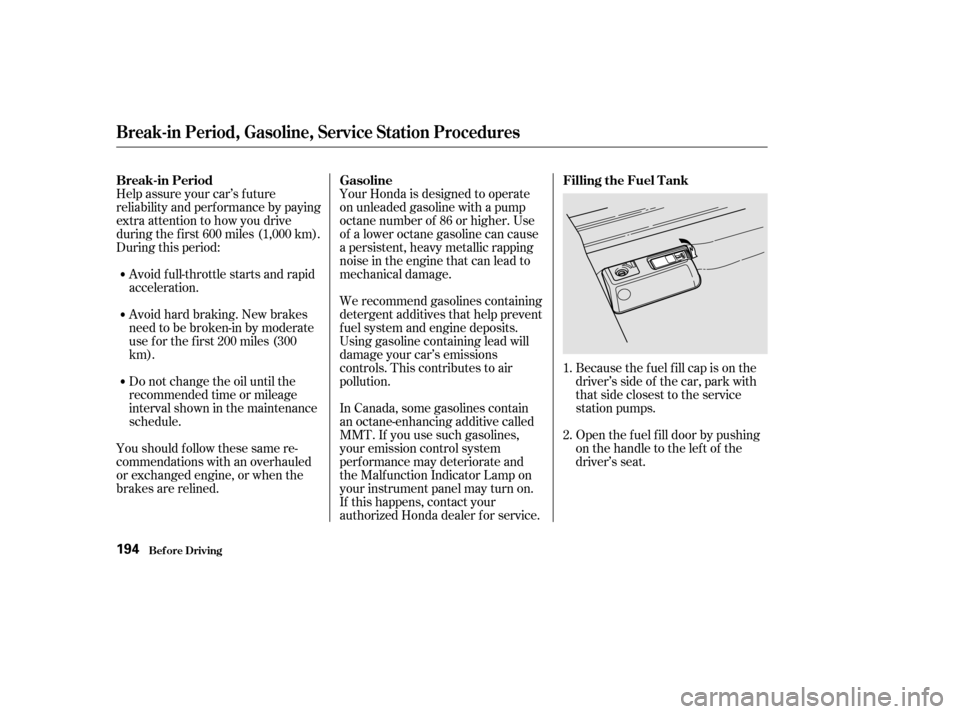
During this period:Avoid full-throttle starts and rapid
acceleration. We recommend gasolines containing
detergent additives that help prevent
f uel system and engine deposits.
Avoidhardbraking.Newbrakes
need to be broken-in by moderate
use f or the f irst 200 miles (300
km). Your Honda is designed to operate
on unleaded gasoline with a pump
octane number of 86 or higher. Use
of a lower octane gasoline can cause
a persistent, heavy metallic rapping
noise in the engine that can lead to
mechanical damage.
Open the f uel f ill door by pushing
onthehandletotheleftof the
driver’s seat.
Help assure your car’s f uture
reliability and perf ormance by paying
extra attention to how you drive
during the f irst 600 miles (1,000 km).
Because the f uel f ill cap is on the
driver’s side of the car, park with
that side closest to the service
station pumps.
In Canada, some gasolines contain
an octane-enhancing additive called
MMT. If you use such gasolines,
your emission control system
perf ormance may deteriorate and
the Malf unction Indicator Lamp on
your instrument panel may turn on.
If this happens, contact your
authorized Honda dealer f or service.
Using gasoline containing lead will
damage your car’s emissions
controls. This contributes to air
pollution.
Youshouldfollowthesesamere-
commendations with an overhauled
or exchanged engine, or when the
brakes are relined. Do not change the oil until the
recommended time or mileage
intervalshowninthemaintenance
schedule.
1. 2.
Bef ore Driving
Break-in Period Gasoline Filling the Fuel Tank
Break-in Period, Gasoline, Service Station Procedures
194
Page 128 of 223
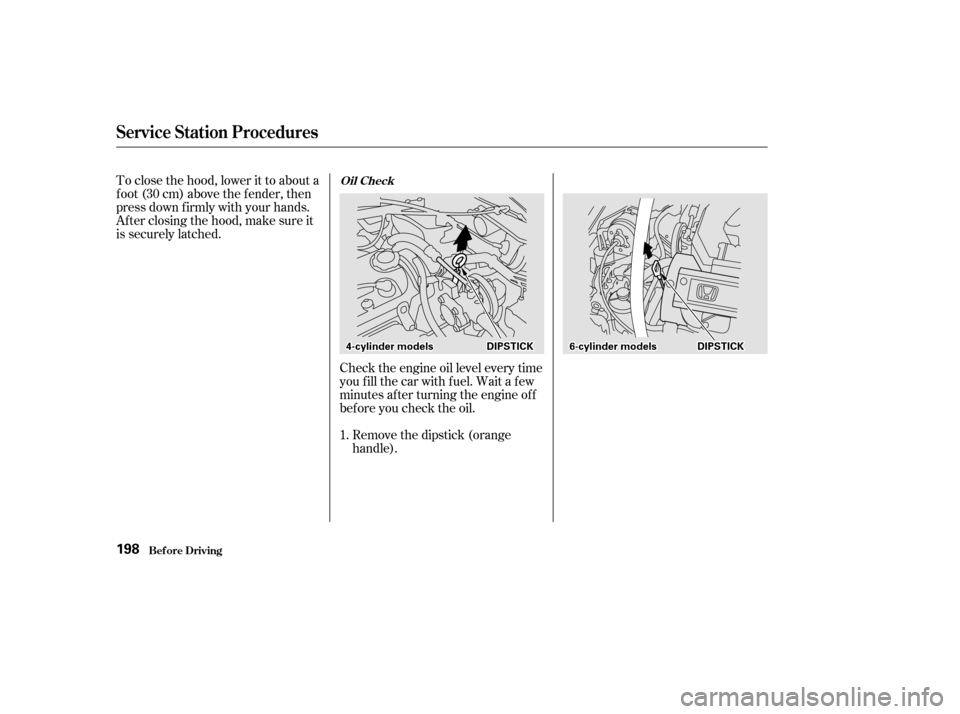
Check the engine oil level every time
you f ill the car with f uel. Wait a f ew
minutes af ter turning the engine of f
bef ore you check the oil.Remove the dipstick (orange
handle).
To close the hood, lower it to about a
f oot (30 cm) above the f ender, then
press down f irmly with your hands.
Afterclosingthehood,makesureit
is securely latched.
1.
Service Station Procedures
Bef ore Driving
Oil Check
198
44--ccyylliinnddeerrmmooddeellssDDIIPPSSTTIICCKK66--ccyylliinnddeerrmmooddeellssDDIIPPSSTTIICCKK
Page 129 of 223
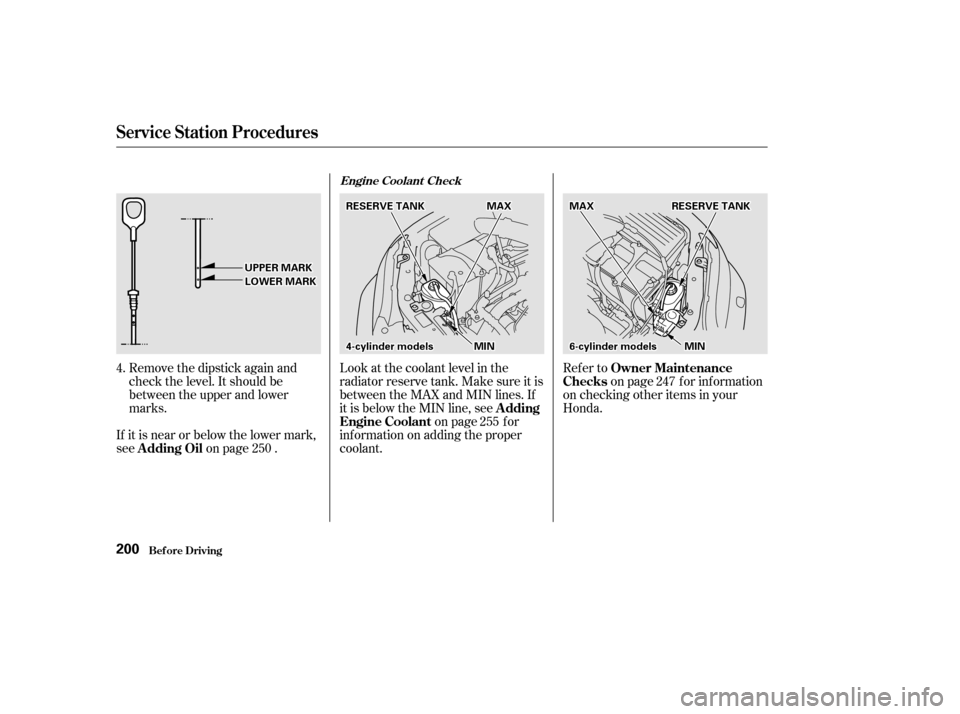
Refer toon page f or inf ormation
on checking other items in your
Honda.
Look at the coolant level in the
radiator reserve tank. Make sure it is
between the MAX and MIN lines. If
it is below the MIN line, see
on page f or
inf ormation on adding the proper
coolant.
Remove the dipstick again and
check the level. It should be
between the upper and lower
marks.
If it is near or below the lower mark,
see on page .
4.
250 247
255
Service Station Procedures
Bef ore Driving
Owner Maintenance
Checks
A dding
Engine Coolant
A dding Oil
Engine Coolant Check
200
MMAAXX
MMIINN44--ccyylliinnddeerrmmooddeellss66--ccyylliinnddeerrmmooddeellss
RREESSEERRVVEETTAANNKKMMAAXX
MMIINN
RREESSEERRVVEETTAANNKK
LLOOWWEERRMMAARRKK
UUPPPPEERRMMAARRKK
Page 130 of 223

A cold engine uses more f uel than a
warm engine. It is not necessary to
‘‘warm-up’’ a cold engine by letting it
idle f or a long time. You can drive
away in about a minute, no matter
how cold it is outside. The engine
will warm up f aster, and you get
better f uel economy. To cut down on
the number of ‘‘cold starts,’’ try to
combine several short trips into one.
You can improve f uel economy by
driving moderately. Rapid acceler-
ation, abrupt cornering, and hard
braking use more f uel.
Always drive in the highest gear that
allows the engine to run and acceler-
ate smoothly.
The air conditioning puts an extra
load on the engine which makes it
usemorefuel.Turnoff theA/Cto
cut down on air conditioning use.
Use the f low-through ventilation
when the outside air temperature is
moderate.
The condition of your car and your
driving habits are the two most
important things that affect the fuel
mileage you get.
Always maintain your car according
to the maintenance schedule. This
will keep it in top operating condition.
Depending on traf f ic conditions, try
to maintain a constant speed. Every
time you slow down and speed up,
your car uses extra f uel. Use the
cruise control, when appropriate, to
increase f uel economy.
An important part of that mainte-
nance is the
(see page ). For
example, an underinf lated tire
causes more ‘‘rolling resistance,’’
which uses f uel. It also wears out
f aster, so check the tire pressure at
least monthly.
In winter, the build-up of snow on
your car’s underside adds weight and
rolling resistance. Frequent cleaning
helps your f uel mileage and reduces
thechanceof corrosion. 247
Vehicle Condition
Driving Habits
Owner Maintenance
Checks
Fuel Economy
Bef ore Driving201
Page 133 of 223

This section gives you tips on
starting the engine under various
conditions, and how to operate the
5-speed manual and automatic
transmissions. It also includes
important inf ormation on parking
your car, the braking system, the
Traction Control System, and facts
you need if you are planning to tow a
trailer.........................
Preparing to Drive . 208
.......................
Starting the Engine . 209
Starting in Cold Weather ....................
at High Altitude . 210
....
5-speed Manual Transmission . 211
.....
Recommended Shif t Points . 212
..............
Engine Speed Limiter . 212
..............
Automatic Transmission . 212
.
Shif t Lever Position Indicator . 213
................
Shif t Lever Positions . 213
..............
Engine Speed Limiter . 216
....................
Shif t Lock Release . 216
...........................................
Parking . 218
.....................
The Braking System . 219
.............
Brake Wear Indicators . 219
...............
Brake System Design . 220
.......................
Anti-lock Brakes . 220
Important Saf ety .........................
Reminders . 221
........................
ABS Indicator . 221
..............
Traction Control System . 222
...............
TCS ON/OFF Switch . 223
............................
TCS Indicator . 223
...............
Driving in Bad Weather . 225
...........................
Towing a Trailer . 227
Driving
Driving207